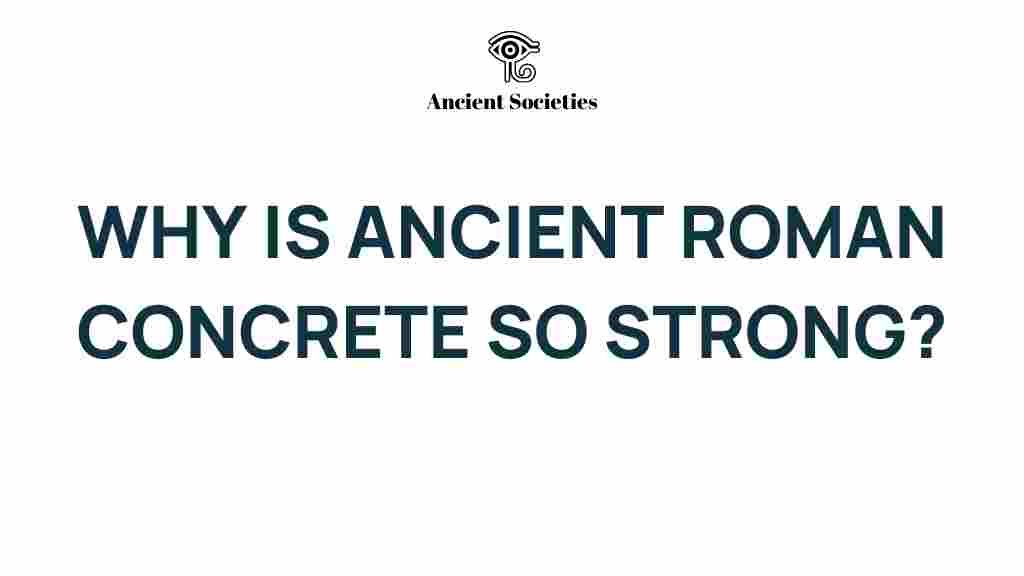Unraveling the Secrets of Ancient Roman Concrete’s Enduring Strength
When we think of the wonders of ancient architecture, the majestic structures of Rome often come to mind. Among these incredible feats is the remarkable Ancient Roman concrete, a material that has baffled modern engineers and architects for centuries with its unparalleled durability and longevity. In this article, we will explore the construction techniques that contributed to the strength of Roman concrete, the historical materials used, and the sustainability of these ancient innovations.
The Marvel of Ancient Roman Concrete
Ancient Roman concrete (opus caementicium) is a composite material that has withstood the test of time, evidenced by enduring structures such as the Pantheon, the Colosseum, and numerous aqueducts. The key to its strength lies not only in its composition but also in the innovative construction techniques employed by Roman engineers.
Composition of Ancient Roman Concrete
The composition of Ancient Roman concrete differs significantly from modern concrete. The primary ingredients included:
- Lime (calcium oxide): The base of the concrete, which, when mixed with water, forms calcium hydroxide.
- Pozzolana: A volcanic ash that reacts with lime and water to create a binding agent, enhancing strength and durability.
- Aggregate: Materials such as crushed stone, brick, or pottery shards, which provided bulk and stability.
- Water: Essential for activating the chemical reactions in the mix.
This unique combination allowed Roman concrete to set underwater, making it ideal for constructing harbors and other aquatic structures.
Construction Techniques: A Masterclass in Engineering
The Romans employed innovative construction techniques that maximized the potential of Ancient Roman concrete. Some of these techniques included:
- Use of Arches: The Romans perfected the arch, which allowed them to distribute weight evenly and create large open spaces without the need for excessive material.
- Formwork and Molds: They utilized wooden molds to shape concrete, allowing for intricate designs and structural complexity.
- Layering Techniques: By layering different materials, they enhanced the tensile strength of their structures.
These methods not only contributed to the aesthetic appeal of Roman architecture but also ensured the longevity of their constructions.
Durability: Why Roman Concrete Has Stood the Test of Time
The durability of Ancient Roman concrete can be attributed to several factors:
- Chemical Reactions: The pozzolanic reaction between lime and volcanic ash resulted in a crystalline structure that is incredibly strong.
- Resistance to Environmental Factors: Roman concrete has shown remarkable resistance to weathering, seawater, and chemical erosion.
- Self-Healing Properties: Some studies suggest that the concrete can heal itself when cracks form, thanks to the presence of water and reactive minerals.
This extraordinary durability is why many Roman structures still stand today, a legacy of their engineering prowess.
Historical Materials: A Closer Look
The materials used in Ancient Roman concrete were locally sourced and often varied depending on the geographic region. This adaptability allowed Romans to maximize the properties of available materials, leading to innovations in construction. Key materials included:
- Volcanic Ash: Found abundantly around regions like Pozzuoli, this material was crucial for the concrete’s strength.
- Local Aggregates: Depending on the area, Romans used natural stones, brick fragments, and even seashells.
The use of these historical materials not only contributed to the strength of the concrete but also showcased the Romans’ ability to harness natural resources sustainably.
Sustainability and Innovation in Roman Engineering
Today’s construction industry is increasingly focused on sustainability, and the techniques developed by the Romans offer valuable lessons. The use of local materials, minimal waste, and durable structures exemplify an ancient approach to sustainability that modern builders can learn from.
Some sustainable practices derived from Roman engineering include:
- Utilization of Natural Resources: The Romans prioritized local materials, reducing transportation costs and environmental impact.
- Longevity of Structures: By focusing on durability, Roman constructions required less frequent repairs and replacements, conserving resources over time.
- Innovative Recycling: The Romans often reused materials from demolished structures, demonstrating early recycling practices.
Preservation of Ancient Roman Concrete
As we continue to uncover the secrets of Ancient Roman concrete, efforts to preserve existing structures are paramount. Here are some methods used to maintain these historical marvels:
- Regular Inspections: Monitoring for signs of wear or damage to address issues proactively.
- Restoration Techniques: Using compatible materials to repair damaged sections without compromising the original structure.
- Research and Development: Ongoing studies into the composition and properties of Roman concrete to inform modern preservation techniques.
Preserving these ancient structures allows future generations to appreciate the ingenuity of Roman engineering.
Common Issues and Troubleshooting Tips
While Ancient Roman concrete has proven to be remarkably durable, certain challenges may arise over time. Here are some common issues and troubleshooting tips:
- Cracking: If cracks appear, assess the size and depth. Smaller cracks may self-heal, while larger ones may require professional evaluation.
- Discoloration: Surface stains can often be cleaned with gentle methods, but if the discoloration persists, consider consulting a preservation expert.
- Structural Integrity: Regular inspections are crucial. If any structural problems are detected, a structural engineer should conduct a thorough assessment.
Conclusion: The Legacy of Ancient Roman Concrete
The engineering marvels of the Romans, particularly their use of Ancient Roman concrete, continue to inspire modern construction techniques. Their innovative approaches to materials and sustainability provide valuable lessons for architects and engineers today. By understanding the durability and construction techniques of this historical material, we can not only appreciate the beauty of ancient architecture but also apply its principles to enhance our modern practices.
As we look to the future, the challenge remains to incorporate the wisdom of the past into sustainable and resilient construction practices. By recognizing the significance of Ancient Roman concrete and its enduring legacy, we can continue to build structures that stand the test of time.
For more insights into ancient construction techniques, visit this resource. To learn about modern sustainable practices in architecture, check out this article.
This article is in the category Archaeology and created by AncientSocieties Team
